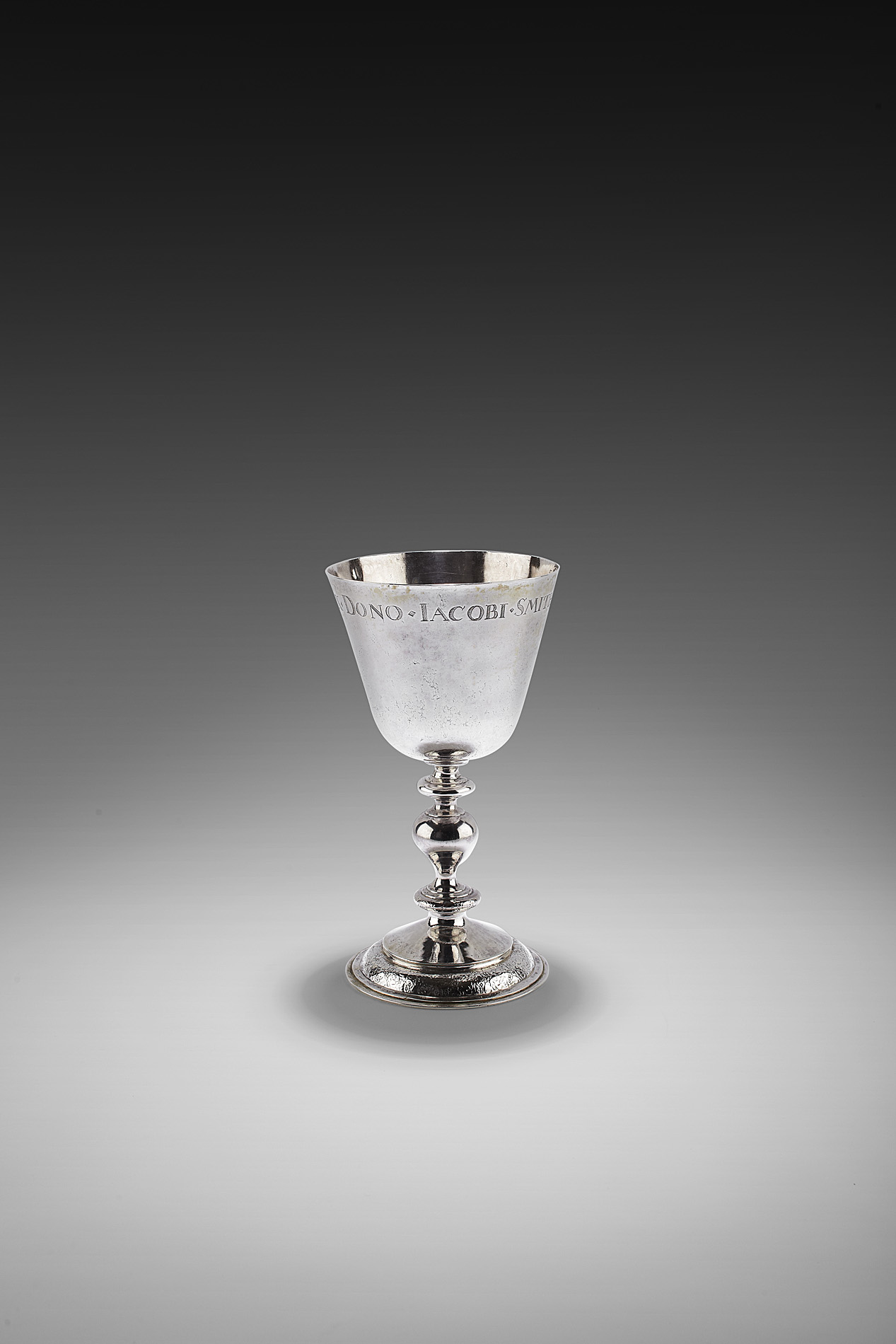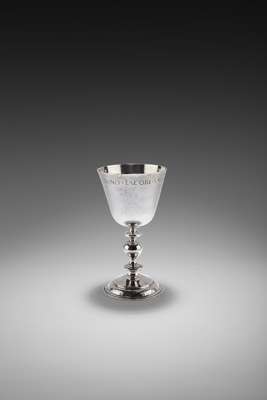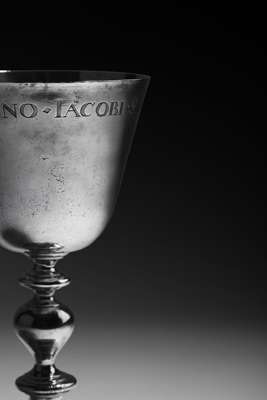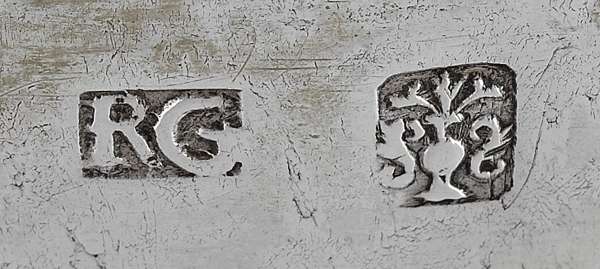
Lot 398

A Charles I communion cup circa 1640










Auction: 14 August 2012 at 15:00 BST
Description
Robert Gardyne II, marked to rim RG, pot of lilies, the tapered bowl engraved around upper rim 'EX DONO IACOBI SMITH MERCATORIS', raised on a tapered baluster knopped stem with foliate decoration cushion lower knop, on a stepped spreading base with flat chased foliate border
Dimensions
Height 23cm, diameter of foot 11.5cm, diameter of bowl 12cm, weight 19.3oz
Footnote
Provenance;
Gifted by James Smith, Merchant, Dundee circa 1640
Kirk Sessions, Steeple Kirk Dundee
Notes: This cup forms part of the main section of the holding within the Steeple Kirk of Dundee, with the original gift of three matching cups commissioned from Robert Gardyne II. All bearing the same inscription and decoration these are the three earliest surviving cups and are amongst the earliest communion plate in Dundee. It is unknown how large the original gift of cups was and seems highly likely that three would not have been the full complement, other cups latterly being recycled and possibly re-worked into the later surviving cups; or even destroyed in the turmoil Dundee has born witness to over the past four centuries. The surviving three cups are now split with the two others held by the Kirk Sessions and within McManus Museums & Galleries collection.
Dundee's Steeple Kirk is one of the most historic and important early buildings within the city. Built in the 12th century by the Earl of Huntington, brother of Scottish King William the Lion, it has withstood the numerous onslaughts of Dundee's tumultuous history to become the city's most important church and its oldest surviving building.
The Earl of Huntington on returning from the Crusades reportedly made a vow that should God deliver his ship safely home he would build a Church in his honour. Upon his arrival he set about constructing the Steeple Kirk, selecting a spot out with the burgh boundaries to do so.
In 1303 the Kirk experienced the first of what would be many reincarnations after the forces of Edward I attacked the city and torched the church; work didn't begin on rebuilding the Kirk until the 15th century, and was completed by the city council in 1462.
Not only a building of importance in Dundee the north and south transepts were the largest of any ecclesiastical building in Europe, while the tower, which was completed in the 1480s is the only original part of the 15th century structure still standing today. This tower would witness the key role the Kirk was to play in the city's history, beginning in 1547 when it was captured by English forces and used as a stable by the soldiers. During this occupation it caught fire, and all but the tower and the choir was burnt to the ground. The council eventually built the west end of the choir and in it established the first Reformation Church of Dundee, further renovations on the destroyed south transept were carried out in the 16th century in order to house a second congregation.
However, this would not be the last of the Kirk's troubles; the English General Monk, under orders from Cromwell besieged the city in 1651, and the tower played an important role in the city's defences. Cannon marks can still be found on the building, a testament to its endurance, and the lock on the door leading from the hall to the stairs is the very same that held it firm against Cromwell's onslaught. In 1759 the north transept was rebuilt, housing a third congregation, and in 1789 the nave was rebuilt allowing a fourth congregation under the Kirk's roof. Until 1841 all four congregations remained under the one roof, each with their own ministers, but sharing the tower and bells.
Even into the Victorian era problems beset the church and in 1841 another fire broke out, this time in the heating system, and once again the transepts were destroyed leaving only the nave and the tower. The Chapter House, adjoining the north wall of the east Church was also burnt down, along with the library of over 1800 volumes, including works in Latin and Greek, many dating from pre-reformation clergy. The east and south transepts were rebuilt in 1844 for their respective congregations, the north transept's congregation was re-housed. These three congregations remained in the one church until the 1980s when they finally amalgamated, giving the Kirk and its congregation its present day appearance.
Little is known about Robert Gardyne II but it is safe to say he forms part of the important Dundee, Perth and St Andrews family of makers who are responsible for some the most important early Scottish plate made in the nations expanding Burgh's. At least three members of the family are recorded and possibly an earlier four member. This would put the spread of the Gardyne's careers at around 1561 - 1708 with Robert Gardyne II falling within the middle of this period known to have been active around 1624 - 1656. It is assumed, as was the tradition within early Goldsmithing families, that Robert was apprenticed to his father Robert Gardyne I also of Dundee and is first mentioned a Freeman of the trade in 1624 within Dundee.
There has often been confusion with the working dates of Gardyne and this has previously caused these cups being attributed as late as 1692. This however was more on the assumption they were presented by James Smith who was harbour master in that year. However the donor appears far more likely to have been James Smith Merchant of Dundee, who died in 1640 and was interned in Dundee's historic graveyard, the Howff.
Gifts of money within wealthy patrons wills for the benefit of the church was not uncommon in Scotland and this date and the known working dates of Gardyne fit far more concretely than previous attributions. Also close comparisons of marks on other dated early Gardyne plate confirms this theory.









